BSc Business Management: Research Proposal on Leadership and Learning
VerifiedAdded on 2023/01/11
|12
|2835
|65
Report
AI Summary
This research proposal investigates the critical relationship between leadership, organizational learning, and company profitability, using Marks & Spencer (M&S) as a case study. The introduction outlines the interconnectedness of leadership and organizational learning, emphasizing their importance for long-term efficiency and employee motivation. The aim is to identify the impact of leadership and learning on business goals and goodwill, with specific objectives including evaluating the importance of leadership, identifying effective leadership theories, and assessing the impact of organizational learning on profitability. The literature review explores various leadership theories and the significance of organizational learning in enhancing company performance. The research methodology section details the use of qualitative and quantitative methods, inductive philosophy, and primary data collection through interviews. Ethical considerations and the expected research outcomes are also discussed. The proposal aims to provide insights into how leadership and organizational learning can drive company success.
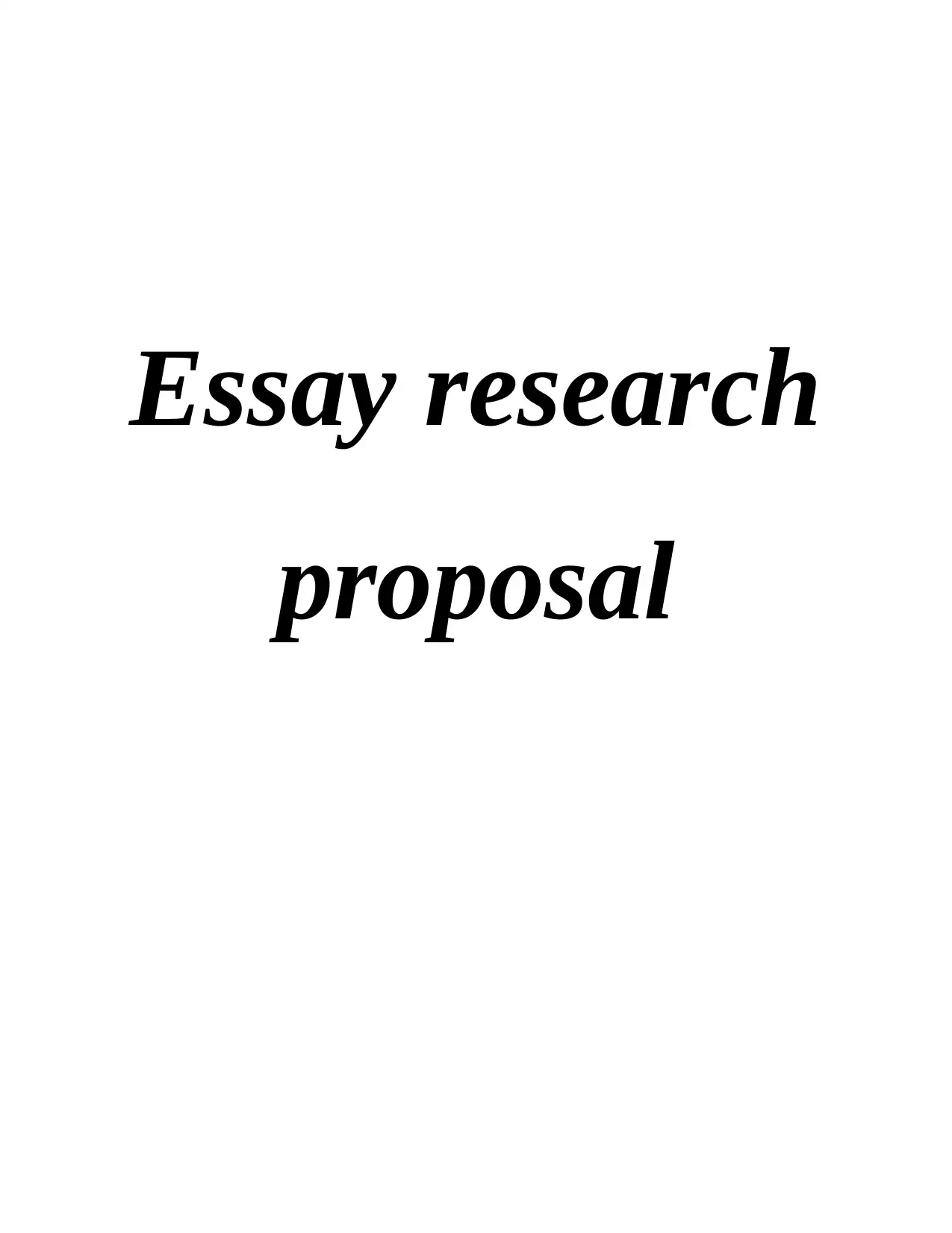
Essay research
proposal
proposal
Paraphrase This Document
Need a fresh take? Get an instant paraphrase of this document with our AI Paraphraser

TABLE OF CONTENT
INTRODUCTION.........................................................................................................................3
Background..................................................................................................................................3
Aim...............................................................................................................................................4
Objectives.....................................................................................................................................4
Research questions.......................................................................................................................4
Rationale......................................................................................................................................4
LITERATURE REVIEW.............................................................................................................5
RESEARCH METHODOLOGY.................................................................................................7
Research methods........................................................................................................................7
Research approach.......................................................................................................................7
Research philosophy....................................................................................................................8
Sampling......................................................................................................................................8
Data collection.............................................................................................................................9
Ethical considerations................................................................................................................10
Research project outcome..........................................................................................................10
REFERENCES............................................................................................................................11
INTRODUCTION.........................................................................................................................3
Background..................................................................................................................................3
Aim...............................................................................................................................................4
Objectives.....................................................................................................................................4
Research questions.......................................................................................................................4
Rationale......................................................................................................................................4
LITERATURE REVIEW.............................................................................................................5
RESEARCH METHODOLOGY.................................................................................................7
Research methods........................................................................................................................7
Research approach.......................................................................................................................7
Research philosophy....................................................................................................................8
Sampling......................................................................................................................................8
Data collection.............................................................................................................................9
Ethical considerations................................................................................................................10
Research project outcome..........................................................................................................10
REFERENCES............................................................................................................................11
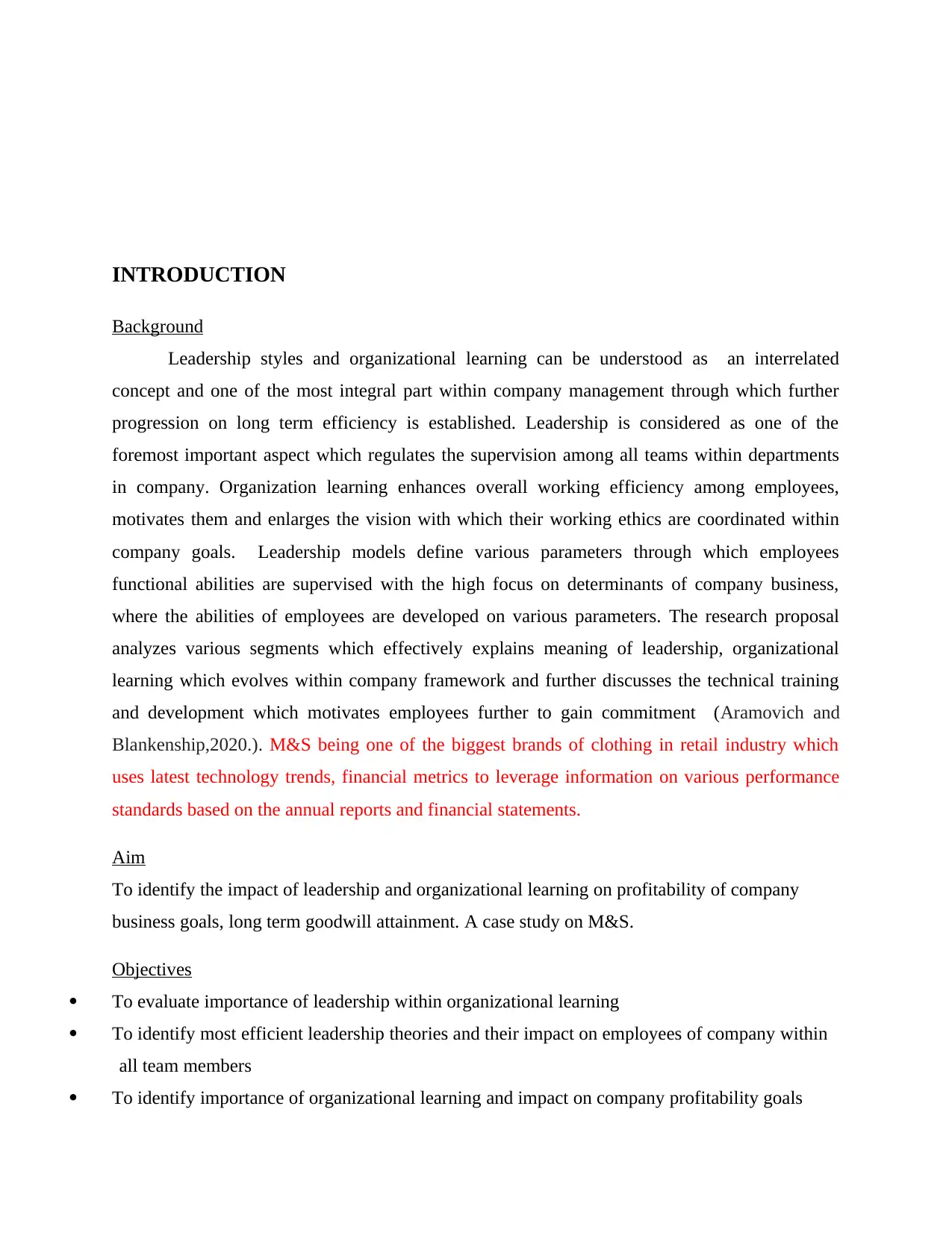
INTRODUCTION
Background
Leadership styles and organizational learning can be understood as an interrelated
concept and one of the most integral part within company management through which further
progression on long term efficiency is established. Leadership is considered as one of the
foremost important aspect which regulates the supervision among all teams within departments
in company. Organization learning enhances overall working efficiency among employees,
motivates them and enlarges the vision with which their working ethics are coordinated within
company goals. Leadership models define various parameters through which employees
functional abilities are supervised with the high focus on determinants of company business,
where the abilities of employees are developed on various parameters. The research proposal
analyzes various segments which effectively explains meaning of leadership, organizational
learning which evolves within company framework and further discusses the technical training
and development which motivates employees further to gain commitment (Aramovich and
Blankenship,2020.). M&S being one of the biggest brands of clothing in retail industry which
uses latest technology trends, financial metrics to leverage information on various performance
standards based on the annual reports and financial statements.
Aim
To identify the impact of leadership and organizational learning on profitability of company
business goals, long term goodwill attainment. A case study on M&S.
Objectives
To evaluate importance of leadership within organizational learning
To identify most efficient leadership theories and their impact on employees of company within
all team members
To identify importance of organizational learning and impact on company profitability goals
Background
Leadership styles and organizational learning can be understood as an interrelated
concept and one of the most integral part within company management through which further
progression on long term efficiency is established. Leadership is considered as one of the
foremost important aspect which regulates the supervision among all teams within departments
in company. Organization learning enhances overall working efficiency among employees,
motivates them and enlarges the vision with which their working ethics are coordinated within
company goals. Leadership models define various parameters through which employees
functional abilities are supervised with the high focus on determinants of company business,
where the abilities of employees are developed on various parameters. The research proposal
analyzes various segments which effectively explains meaning of leadership, organizational
learning which evolves within company framework and further discusses the technical training
and development which motivates employees further to gain commitment (Aramovich and
Blankenship,2020.). M&S being one of the biggest brands of clothing in retail industry which
uses latest technology trends, financial metrics to leverage information on various performance
standards based on the annual reports and financial statements.
Aim
To identify the impact of leadership and organizational learning on profitability of company
business goals, long term goodwill attainment. A case study on M&S.
Objectives
To evaluate importance of leadership within organizational learning
To identify most efficient leadership theories and their impact on employees of company within
all team members
To identify importance of organizational learning and impact on company profitability goals
⊘ This is a preview!⊘
Do you want full access?
Subscribe today to unlock all pages.

Trusted by 1+ million students worldwide
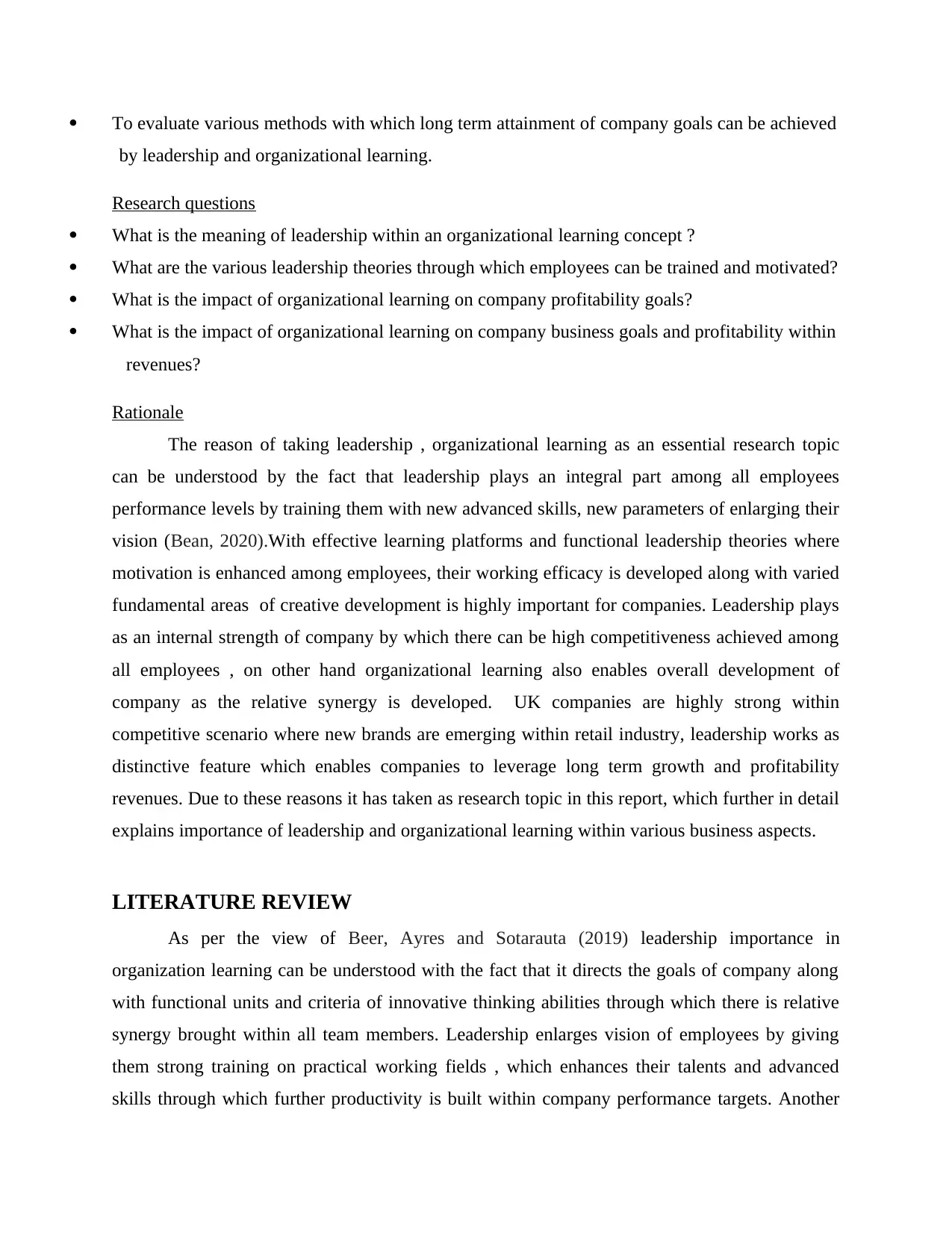
To evaluate various methods with which long term attainment of company goals can be achieved
by leadership and organizational learning.
Research questions
What is the meaning of leadership within an organizational learning concept ?
What are the various leadership theories through which employees can be trained and motivated?
What is the impact of organizational learning on company profitability goals?
What is the impact of organizational learning on company business goals and profitability within
revenues?
Rationale
The reason of taking leadership , organizational learning as an essential research topic
can be understood by the fact that leadership plays an integral part among all employees
performance levels by training them with new advanced skills, new parameters of enlarging their
vision (Bean, 2020).With effective learning platforms and functional leadership theories where
motivation is enhanced among employees, their working efficacy is developed along with varied
fundamental areas of creative development is highly important for companies. Leadership plays
as an internal strength of company by which there can be high competitiveness achieved among
all employees , on other hand organizational learning also enables overall development of
company as the relative synergy is developed. UK companies are highly strong within
competitive scenario where new brands are emerging within retail industry, leadership works as
distinctive feature which enables companies to leverage long term growth and profitability
revenues. Due to these reasons it has taken as research topic in this report, which further in detail
explains importance of leadership and organizational learning within various business aspects.
LITERATURE REVIEW
As per the view of Beer, Ayres and Sotarauta (2019) leadership importance in
organization learning can be understood with the fact that it directs the goals of company along
with functional units and criteria of innovative thinking abilities through which there is relative
synergy brought within all team members. Leadership enlarges vision of employees by giving
them strong training on practical working fields , which enhances their talents and advanced
skills through which further productivity is built within company performance targets. Another
by leadership and organizational learning.
Research questions
What is the meaning of leadership within an organizational learning concept ?
What are the various leadership theories through which employees can be trained and motivated?
What is the impact of organizational learning on company profitability goals?
What is the impact of organizational learning on company business goals and profitability within
revenues?
Rationale
The reason of taking leadership , organizational learning as an essential research topic
can be understood by the fact that leadership plays an integral part among all employees
performance levels by training them with new advanced skills, new parameters of enlarging their
vision (Bean, 2020).With effective learning platforms and functional leadership theories where
motivation is enhanced among employees, their working efficacy is developed along with varied
fundamental areas of creative development is highly important for companies. Leadership plays
as an internal strength of company by which there can be high competitiveness achieved among
all employees , on other hand organizational learning also enables overall development of
company as the relative synergy is developed. UK companies are highly strong within
competitive scenario where new brands are emerging within retail industry, leadership works as
distinctive feature which enables companies to leverage long term growth and profitability
revenues. Due to these reasons it has taken as research topic in this report, which further in detail
explains importance of leadership and organizational learning within various business aspects.
LITERATURE REVIEW
As per the view of Beer, Ayres and Sotarauta (2019) leadership importance in
organization learning can be understood with the fact that it directs the goals of company along
with functional units and criteria of innovative thinking abilities through which there is relative
synergy brought within all team members. Leadership enlarges vision of employees by giving
them strong training on practical working fields , which enhances their talents and advanced
skills through which further productivity is built within company performance targets. Another
Paraphrase This Document
Need a fresh take? Get an instant paraphrase of this document with our AI Paraphraser
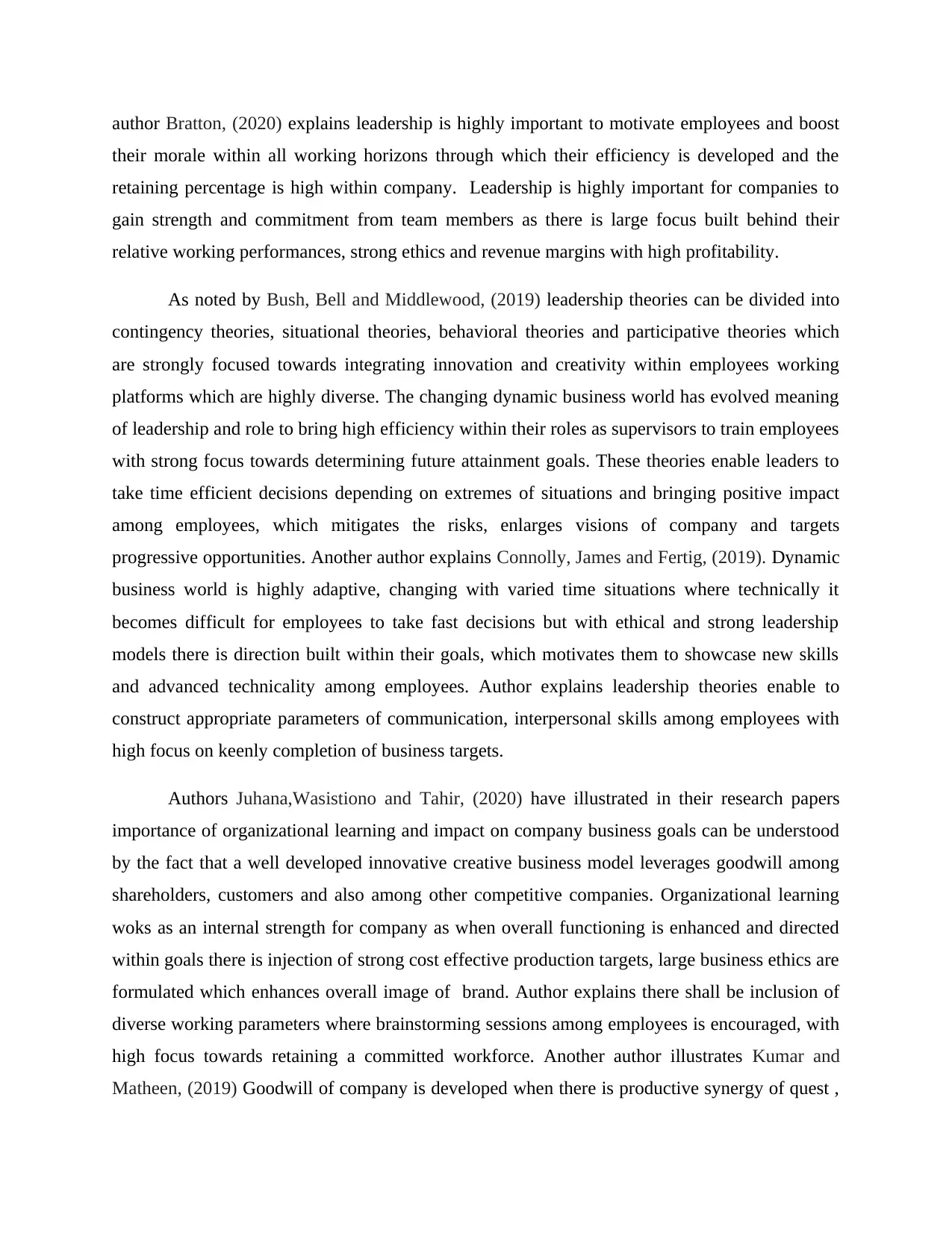
author Bratton, (2020) explains leadership is highly important to motivate employees and boost
their morale within all working horizons through which their efficiency is developed and the
retaining percentage is high within company. Leadership is highly important for companies to
gain strength and commitment from team members as there is large focus built behind their
relative working performances, strong ethics and revenue margins with high profitability.
As noted by Bush, Bell and Middlewood, (2019) leadership theories can be divided into
contingency theories, situational theories, behavioral theories and participative theories which
are strongly focused towards integrating innovation and creativity within employees working
platforms which are highly diverse. The changing dynamic business world has evolved meaning
of leadership and role to bring high efficiency within their roles as supervisors to train employees
with strong focus towards determining future attainment goals. These theories enable leaders to
take time efficient decisions depending on extremes of situations and bringing positive impact
among employees, which mitigates the risks, enlarges visions of company and targets
progressive opportunities. Another author explains Connolly, James and Fertig, (2019). Dynamic
business world is highly adaptive, changing with varied time situations where technically it
becomes difficult for employees to take fast decisions but with ethical and strong leadership
models there is direction built within their goals, which motivates them to showcase new skills
and advanced technicality among employees. Author explains leadership theories enable to
construct appropriate parameters of communication, interpersonal skills among employees with
high focus on keenly completion of business targets.
Authors Juhana,Wasistiono and Tahir, (2020) have illustrated in their research papers
importance of organizational learning and impact on company business goals can be understood
by the fact that a well developed innovative creative business model leverages goodwill among
shareholders, customers and also among other competitive companies. Organizational learning
woks as an internal strength for company as when overall functioning is enhanced and directed
within goals there is injection of strong cost effective production targets, large business ethics are
formulated which enhances overall image of brand. Author explains there shall be inclusion of
diverse working parameters where brainstorming sessions among employees is encouraged, with
high focus towards retaining a committed workforce. Another author illustrates Kumar and
Matheen, (2019) Goodwill of company is developed when there is productive synergy of quest ,
their morale within all working horizons through which their efficiency is developed and the
retaining percentage is high within company. Leadership is highly important for companies to
gain strength and commitment from team members as there is large focus built behind their
relative working performances, strong ethics and revenue margins with high profitability.
As noted by Bush, Bell and Middlewood, (2019) leadership theories can be divided into
contingency theories, situational theories, behavioral theories and participative theories which
are strongly focused towards integrating innovation and creativity within employees working
platforms which are highly diverse. The changing dynamic business world has evolved meaning
of leadership and role to bring high efficiency within their roles as supervisors to train employees
with strong focus towards determining future attainment goals. These theories enable leaders to
take time efficient decisions depending on extremes of situations and bringing positive impact
among employees, which mitigates the risks, enlarges visions of company and targets
progressive opportunities. Another author explains Connolly, James and Fertig, (2019). Dynamic
business world is highly adaptive, changing with varied time situations where technically it
becomes difficult for employees to take fast decisions but with ethical and strong leadership
models there is direction built within their goals, which motivates them to showcase new skills
and advanced technicality among employees. Author explains leadership theories enable to
construct appropriate parameters of communication, interpersonal skills among employees with
high focus on keenly completion of business targets.
Authors Juhana,Wasistiono and Tahir, (2020) have illustrated in their research papers
importance of organizational learning and impact on company business goals can be understood
by the fact that a well developed innovative creative business model leverages goodwill among
shareholders, customers and also among other competitive companies. Organizational learning
woks as an internal strength for company as when overall functioning is enhanced and directed
within goals there is injection of strong cost effective production targets, large business ethics are
formulated which enhances overall image of brand. Author explains there shall be inclusion of
diverse working parameters where brainstorming sessions among employees is encouraged, with
high focus towards retaining a committed workforce. Another author illustrates Kumar and
Matheen, (2019) Goodwill of company is developed when there is productive synergy of quest ,
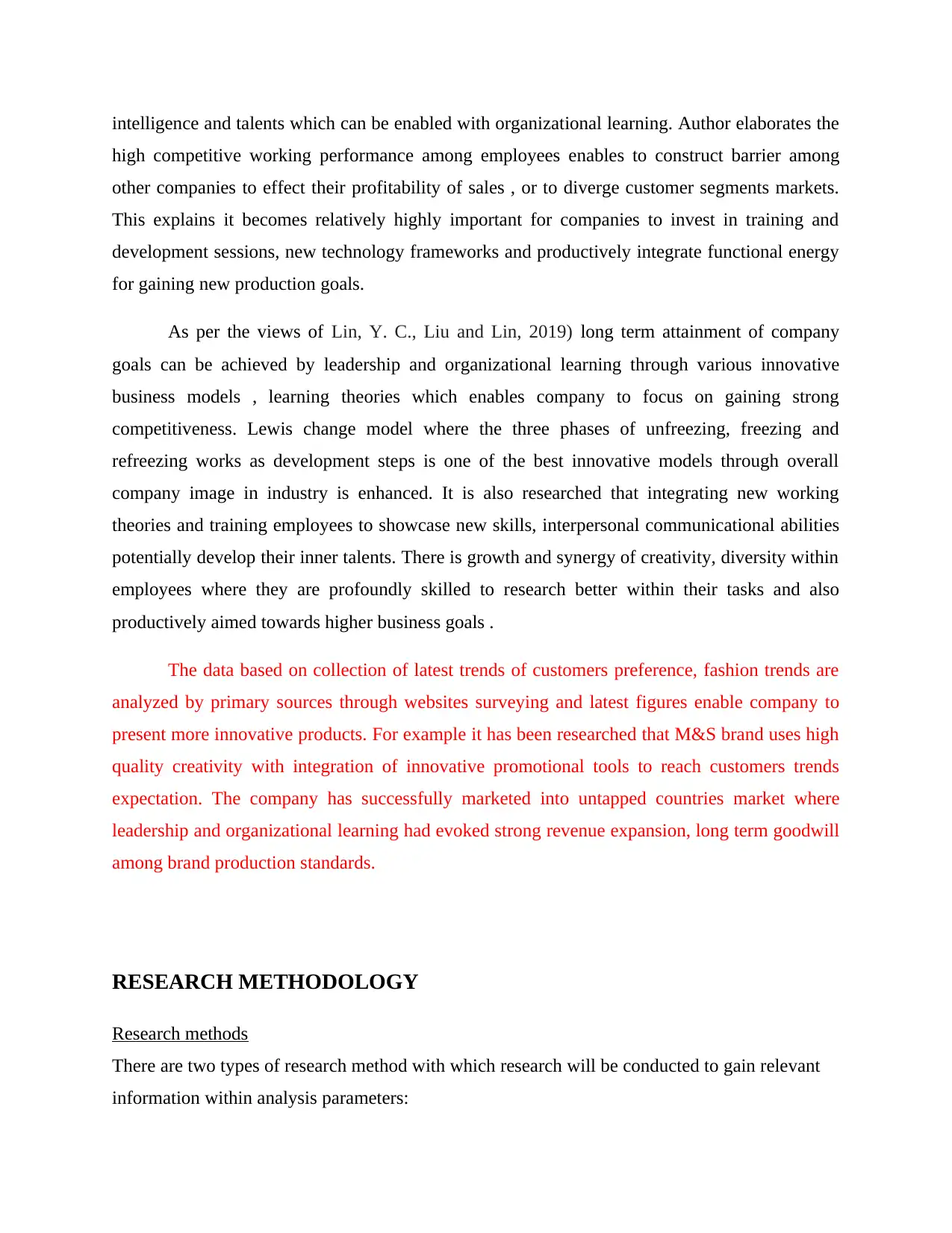
intelligence and talents which can be enabled with organizational learning. Author elaborates the
high competitive working performance among employees enables to construct barrier among
other companies to effect their profitability of sales , or to diverge customer segments markets.
This explains it becomes relatively highly important for companies to invest in training and
development sessions, new technology frameworks and productively integrate functional energy
for gaining new production goals.
As per the views of Lin, Y. C., Liu and Lin, 2019) long term attainment of company
goals can be achieved by leadership and organizational learning through various innovative
business models , learning theories which enables company to focus on gaining strong
competitiveness. Lewis change model where the three phases of unfreezing, freezing and
refreezing works as development steps is one of the best innovative models through overall
company image in industry is enhanced. It is also researched that integrating new working
theories and training employees to showcase new skills, interpersonal communicational abilities
potentially develop their inner talents. There is growth and synergy of creativity, diversity within
employees where they are profoundly skilled to research better within their tasks and also
productively aimed towards higher business goals .
The data based on collection of latest trends of customers preference, fashion trends are
analyzed by primary sources through websites surveying and latest figures enable company to
present more innovative products. For example it has been researched that M&S brand uses high
quality creativity with integration of innovative promotional tools to reach customers trends
expectation. The company has successfully marketed into untapped countries market where
leadership and organizational learning had evoked strong revenue expansion, long term goodwill
among brand production standards.
RESEARCH METHODOLOGY
Research methods
There are two types of research method with which research will be conducted to gain relevant
information within analysis parameters:
high competitive working performance among employees enables to construct barrier among
other companies to effect their profitability of sales , or to diverge customer segments markets.
This explains it becomes relatively highly important for companies to invest in training and
development sessions, new technology frameworks and productively integrate functional energy
for gaining new production goals.
As per the views of Lin, Y. C., Liu and Lin, 2019) long term attainment of company
goals can be achieved by leadership and organizational learning through various innovative
business models , learning theories which enables company to focus on gaining strong
competitiveness. Lewis change model where the three phases of unfreezing, freezing and
refreezing works as development steps is one of the best innovative models through overall
company image in industry is enhanced. It is also researched that integrating new working
theories and training employees to showcase new skills, interpersonal communicational abilities
potentially develop their inner talents. There is growth and synergy of creativity, diversity within
employees where they are profoundly skilled to research better within their tasks and also
productively aimed towards higher business goals .
The data based on collection of latest trends of customers preference, fashion trends are
analyzed by primary sources through websites surveying and latest figures enable company to
present more innovative products. For example it has been researched that M&S brand uses high
quality creativity with integration of innovative promotional tools to reach customers trends
expectation. The company has successfully marketed into untapped countries market where
leadership and organizational learning had evoked strong revenue expansion, long term goodwill
among brand production standards.
RESEARCH METHODOLOGY
Research methods
There are two types of research method with which research will be conducted to gain relevant
information within analysis parameters:
⊘ This is a preview!⊘
Do you want full access?
Subscribe today to unlock all pages.

Trusted by 1+ million students worldwide
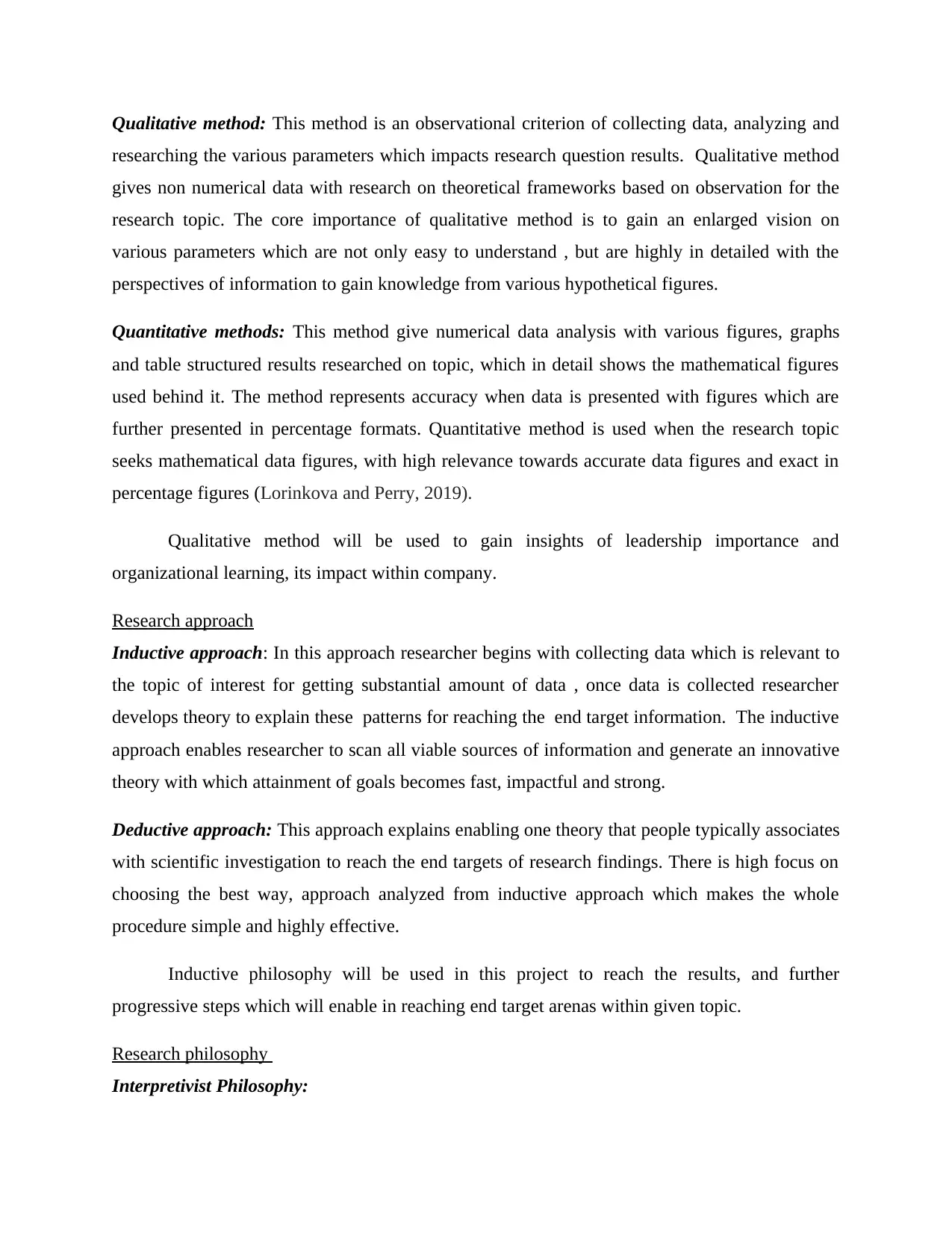
Qualitative method: This method is an observational criterion of collecting data, analyzing and
researching the various parameters which impacts research question results. Qualitative method
gives non numerical data with research on theoretical frameworks based on observation for the
research topic. The core importance of qualitative method is to gain an enlarged vision on
various parameters which are not only easy to understand , but are highly in detailed with the
perspectives of information to gain knowledge from various hypothetical figures.
Quantitative methods: This method give numerical data analysis with various figures, graphs
and table structured results researched on topic, which in detail shows the mathematical figures
used behind it. The method represents accuracy when data is presented with figures which are
further presented in percentage formats. Quantitative method is used when the research topic
seeks mathematical data figures, with high relevance towards accurate data figures and exact in
percentage figures (Lorinkova and Perry, 2019).
Qualitative method will be used to gain insights of leadership importance and
organizational learning, its impact within company.
Research approach
Inductive approach: In this approach researcher begins with collecting data which is relevant to
the topic of interest for getting substantial amount of data , once data is collected researcher
develops theory to explain these patterns for reaching the end target information. The inductive
approach enables researcher to scan all viable sources of information and generate an innovative
theory with which attainment of goals becomes fast, impactful and strong.
Deductive approach: This approach explains enabling one theory that people typically associates
with scientific investigation to reach the end targets of research findings. There is high focus on
choosing the best way, approach analyzed from inductive approach which makes the whole
procedure simple and highly effective.
Inductive philosophy will be used in this project to reach the results, and further
progressive steps which will enable in reaching end target arenas within given topic.
Research philosophy
Interpretivist Philosophy:
researching the various parameters which impacts research question results. Qualitative method
gives non numerical data with research on theoretical frameworks based on observation for the
research topic. The core importance of qualitative method is to gain an enlarged vision on
various parameters which are not only easy to understand , but are highly in detailed with the
perspectives of information to gain knowledge from various hypothetical figures.
Quantitative methods: This method give numerical data analysis with various figures, graphs
and table structured results researched on topic, which in detail shows the mathematical figures
used behind it. The method represents accuracy when data is presented with figures which are
further presented in percentage formats. Quantitative method is used when the research topic
seeks mathematical data figures, with high relevance towards accurate data figures and exact in
percentage figures (Lorinkova and Perry, 2019).
Qualitative method will be used to gain insights of leadership importance and
organizational learning, its impact within company.
Research approach
Inductive approach: In this approach researcher begins with collecting data which is relevant to
the topic of interest for getting substantial amount of data , once data is collected researcher
develops theory to explain these patterns for reaching the end target information. The inductive
approach enables researcher to scan all viable sources of information and generate an innovative
theory with which attainment of goals becomes fast, impactful and strong.
Deductive approach: This approach explains enabling one theory that people typically associates
with scientific investigation to reach the end targets of research findings. There is high focus on
choosing the best way, approach analyzed from inductive approach which makes the whole
procedure simple and highly effective.
Inductive philosophy will be used in this project to reach the results, and further
progressive steps which will enable in reaching end target arenas within given topic.
Research philosophy
Interpretivist Philosophy:
Paraphrase This Document
Need a fresh take? Get an instant paraphrase of this document with our AI Paraphraser
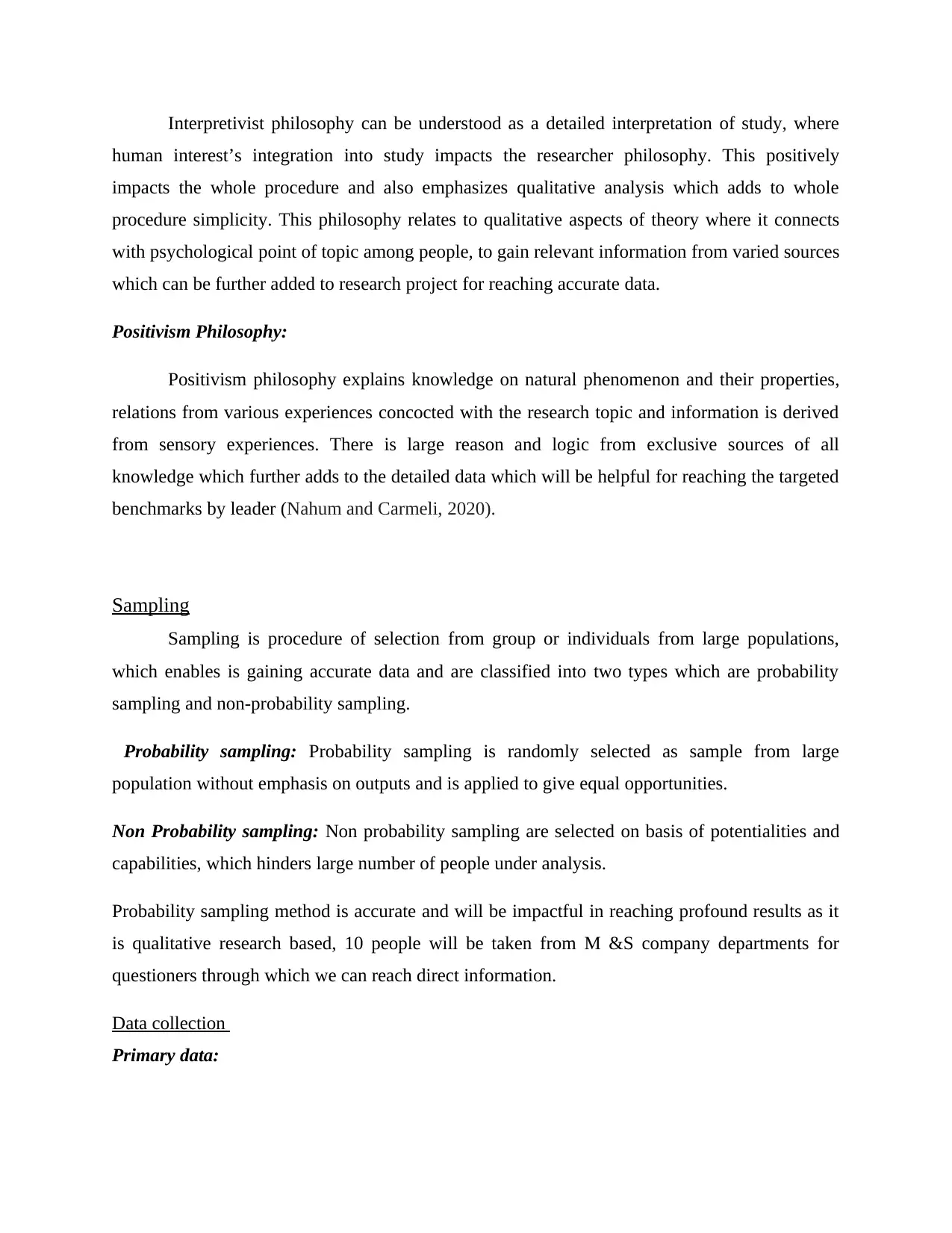
Interpretivist philosophy can be understood as a detailed interpretation of study, where
human interest’s integration into study impacts the researcher philosophy. This positively
impacts the whole procedure and also emphasizes qualitative analysis which adds to whole
procedure simplicity. This philosophy relates to qualitative aspects of theory where it connects
with psychological point of topic among people, to gain relevant information from varied sources
which can be further added to research project for reaching accurate data.
Positivism Philosophy:
Positivism philosophy explains knowledge on natural phenomenon and their properties,
relations from various experiences concocted with the research topic and information is derived
from sensory experiences. There is large reason and logic from exclusive sources of all
knowledge which further adds to the detailed data which will be helpful for reaching the targeted
benchmarks by leader (Nahum and Carmeli, 2020).
Sampling
Sampling is procedure of selection from group or individuals from large populations,
which enables is gaining accurate data and are classified into two types which are probability
sampling and non-probability sampling.
Probability sampling: Probability sampling is randomly selected as sample from large
population without emphasis on outputs and is applied to give equal opportunities.
Non Probability sampling: Non probability sampling are selected on basis of potentialities and
capabilities, which hinders large number of people under analysis.
Probability sampling method is accurate and will be impactful in reaching profound results as it
is qualitative research based, 10 people will be taken from M &S company departments for
questioners through which we can reach direct information.
Data collection
Primary data:
human interest’s integration into study impacts the researcher philosophy. This positively
impacts the whole procedure and also emphasizes qualitative analysis which adds to whole
procedure simplicity. This philosophy relates to qualitative aspects of theory where it connects
with psychological point of topic among people, to gain relevant information from varied sources
which can be further added to research project for reaching accurate data.
Positivism Philosophy:
Positivism philosophy explains knowledge on natural phenomenon and their properties,
relations from various experiences concocted with the research topic and information is derived
from sensory experiences. There is large reason and logic from exclusive sources of all
knowledge which further adds to the detailed data which will be helpful for reaching the targeted
benchmarks by leader (Nahum and Carmeli, 2020).
Sampling
Sampling is procedure of selection from group or individuals from large populations,
which enables is gaining accurate data and are classified into two types which are probability
sampling and non-probability sampling.
Probability sampling: Probability sampling is randomly selected as sample from large
population without emphasis on outputs and is applied to give equal opportunities.
Non Probability sampling: Non probability sampling are selected on basis of potentialities and
capabilities, which hinders large number of people under analysis.
Probability sampling method is accurate and will be impactful in reaching profound results as it
is qualitative research based, 10 people will be taken from M &S company departments for
questioners through which we can reach direct information.
Data collection
Primary data:

Primary data collection is collected from researcher first hand sources with sources of
surveys, interviews and experiments based on the research topic which are directly connected
with sources. Primary data is trustworthy and strongly relevant with the latest information and
statistics which enable researcher to get accurate results within the set benchmarks.
Secondary data:
Secondary data collection is collected from another sources which are not direct and are
interpreted from varied sources, which affects its authenticity and reliability on varied level.
Secondary data analysis is recommended when projects are lately connected on diverse platforms
among public.
The project will use only primary data sources to use only relevant sources of
information, statistics to functionally enable get direct information from public, people working
in company through which project targets can be reached.
Questioners:
1 How often are training sessions organized within production department at M &S
Once a weak
Twice a month
Once a month
2 Are the leaders supportive towards motivation and training in company towards employees ?
Yes
No
3 Is the organizational learning promoted within culture at M&S ?
Yes
No
4 Are you satisfied with the training an d development sessions within company frameworks?
Yes
surveys, interviews and experiments based on the research topic which are directly connected
with sources. Primary data is trustworthy and strongly relevant with the latest information and
statistics which enable researcher to get accurate results within the set benchmarks.
Secondary data:
Secondary data collection is collected from another sources which are not direct and are
interpreted from varied sources, which affects its authenticity and reliability on varied level.
Secondary data analysis is recommended when projects are lately connected on diverse platforms
among public.
The project will use only primary data sources to use only relevant sources of
information, statistics to functionally enable get direct information from public, people working
in company through which project targets can be reached.
Questioners:
1 How often are training sessions organized within production department at M &S
Once a weak
Twice a month
Once a month
2 Are the leaders supportive towards motivation and training in company towards employees ?
Yes
No
3 Is the organizational learning promoted within culture at M&S ?
Yes
No
4 Are you satisfied with the training an d development sessions within company frameworks?
Yes
⊘ This is a preview!⊘
Do you want full access?
Subscribe today to unlock all pages.

Trusted by 1+ million students worldwide

No
5 Do you look forward to work in M&S?
Yes
No
Ethical considerations
All the sources used for information collection is from reliable sources and there is no
case of plagiarism, further the employees of company are directly contacted without any biases.
Research project outcome
The research will enable to get detailed explanation on varied topics which explain
leadership importance and organizational learning in company for attainment of goodwill and
high potential profitability goals. Research will highlight various fundamental aspects of
leadership and organizational learning, as they work together as an interrelated concept which
retains employees for long term in company, leverages determinants of company goals and
functionally enlarges their vision towards responsibilities at departments (Ni, Rorrer, and
Korach, 2019).
5 Do you look forward to work in M&S?
Yes
No
Ethical considerations
All the sources used for information collection is from reliable sources and there is no
case of plagiarism, further the employees of company are directly contacted without any biases.
Research project outcome
The research will enable to get detailed explanation on varied topics which explain
leadership importance and organizational learning in company for attainment of goodwill and
high potential profitability goals. Research will highlight various fundamental aspects of
leadership and organizational learning, as they work together as an interrelated concept which
retains employees for long term in company, leverages determinants of company goals and
functionally enlarges their vision towards responsibilities at departments (Ni, Rorrer, and
Korach, 2019).
Paraphrase This Document
Need a fresh take? Get an instant paraphrase of this document with our AI Paraphraser
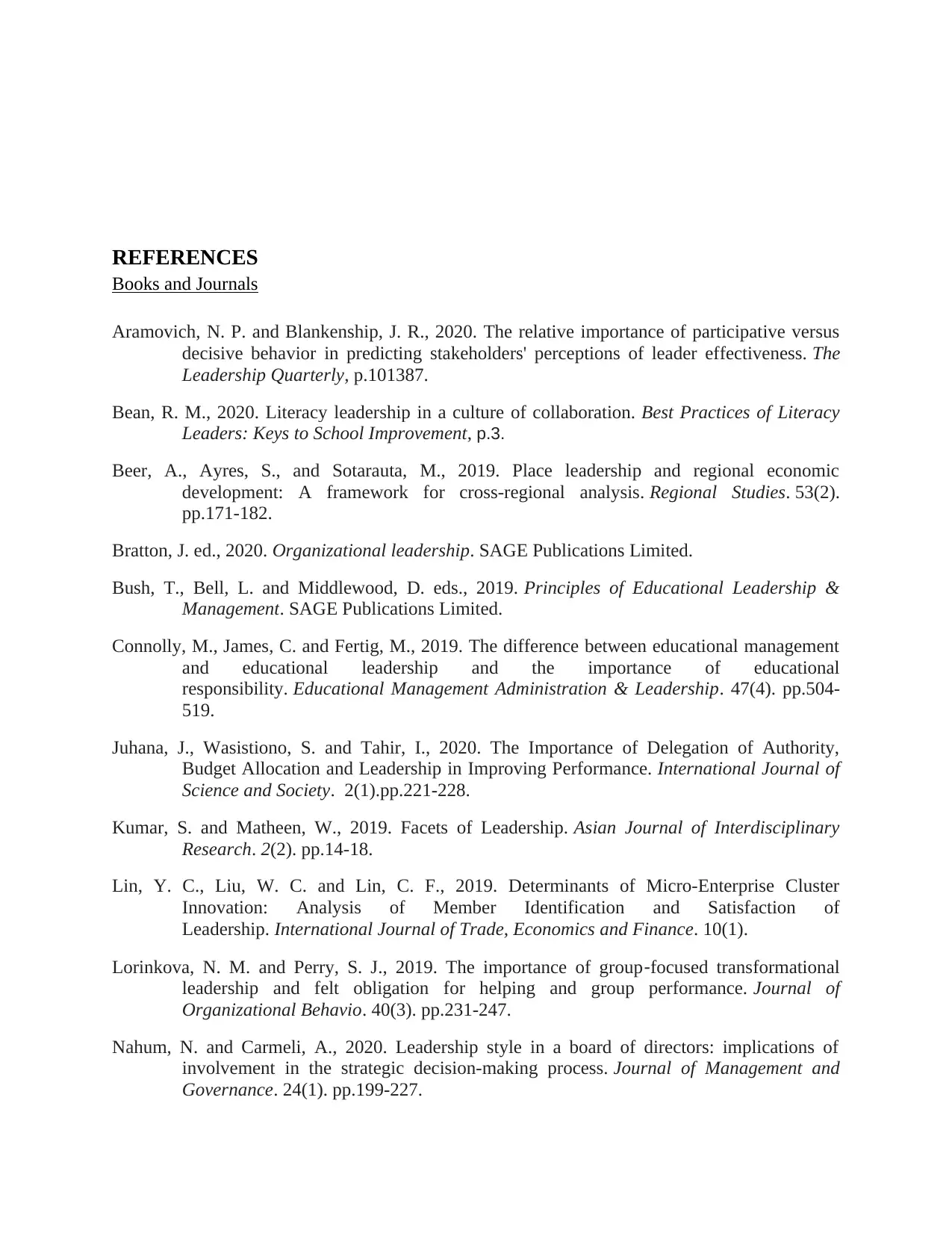
REFERENCES
Books and Journals
Aramovich, N. P. and Blankenship, J. R., 2020. The relative importance of participative versus
decisive behavior in predicting stakeholders' perceptions of leader effectiveness. The
Leadership Quarterly, p.101387.
Bean, R. M., 2020. Literacy leadership in a culture of collaboration. Best Practices of Literacy
Leaders: Keys to School Improvement, p.3.
Beer, A., Ayres, S., and Sotarauta, M., 2019. Place leadership and regional economic
development: A framework for cross-regional analysis. Regional Studies. 53(2).
pp.171-182.
Bratton, J. ed., 2020. Organizational leadership. SAGE Publications Limited.
Bush, T., Bell, L. and Middlewood, D. eds., 2019. Principles of Educational Leadership &
Management. SAGE Publications Limited.
Connolly, M., James, C. and Fertig, M., 2019. The difference between educational management
and educational leadership and the importance of educational
responsibility. Educational Management Administration & Leadership. 47(4). pp.504-
519.
Juhana, J., Wasistiono, S. and Tahir, I., 2020. The Importance of Delegation of Authority,
Budget Allocation and Leadership in Improving Performance. International Journal of
Science and Society. 2(1).pp.221-228.
Kumar, S. and Matheen, W., 2019. Facets of Leadership. Asian Journal of Interdisciplinary
Research. 2(2). pp.14-18.
Lin, Y. C., Liu, W. C. and Lin, C. F., 2019. Determinants of Micro-Enterprise Cluster
Innovation: Analysis of Member Identification and Satisfaction of
Leadership. International Journal of Trade, Economics and Finance. 10(1).
Lorinkova, N. M. and Perry, S. J., 2019. The importance of group‐focused transformational
leadership and felt obligation for helping and group performance. Journal of
Organizational Behavio. 40(3). pp.231-247.
Nahum, N. and Carmeli, A., 2020. Leadership style in a board of directors: implications of
involvement in the strategic decision-making process. Journal of Management and
Governance. 24(1). pp.199-227.
Books and Journals
Aramovich, N. P. and Blankenship, J. R., 2020. The relative importance of participative versus
decisive behavior in predicting stakeholders' perceptions of leader effectiveness. The
Leadership Quarterly, p.101387.
Bean, R. M., 2020. Literacy leadership in a culture of collaboration. Best Practices of Literacy
Leaders: Keys to School Improvement, p.3.
Beer, A., Ayres, S., and Sotarauta, M., 2019. Place leadership and regional economic
development: A framework for cross-regional analysis. Regional Studies. 53(2).
pp.171-182.
Bratton, J. ed., 2020. Organizational leadership. SAGE Publications Limited.
Bush, T., Bell, L. and Middlewood, D. eds., 2019. Principles of Educational Leadership &
Management. SAGE Publications Limited.
Connolly, M., James, C. and Fertig, M., 2019. The difference between educational management
and educational leadership and the importance of educational
responsibility. Educational Management Administration & Leadership. 47(4). pp.504-
519.
Juhana, J., Wasistiono, S. and Tahir, I., 2020. The Importance of Delegation of Authority,
Budget Allocation and Leadership in Improving Performance. International Journal of
Science and Society. 2(1).pp.221-228.
Kumar, S. and Matheen, W., 2019. Facets of Leadership. Asian Journal of Interdisciplinary
Research. 2(2). pp.14-18.
Lin, Y. C., Liu, W. C. and Lin, C. F., 2019. Determinants of Micro-Enterprise Cluster
Innovation: Analysis of Member Identification and Satisfaction of
Leadership. International Journal of Trade, Economics and Finance. 10(1).
Lorinkova, N. M. and Perry, S. J., 2019. The importance of group‐focused transformational
leadership and felt obligation for helping and group performance. Journal of
Organizational Behavio. 40(3). pp.231-247.
Nahum, N. and Carmeli, A., 2020. Leadership style in a board of directors: implications of
involvement in the strategic decision-making process. Journal of Management and
Governance. 24(1). pp.199-227.
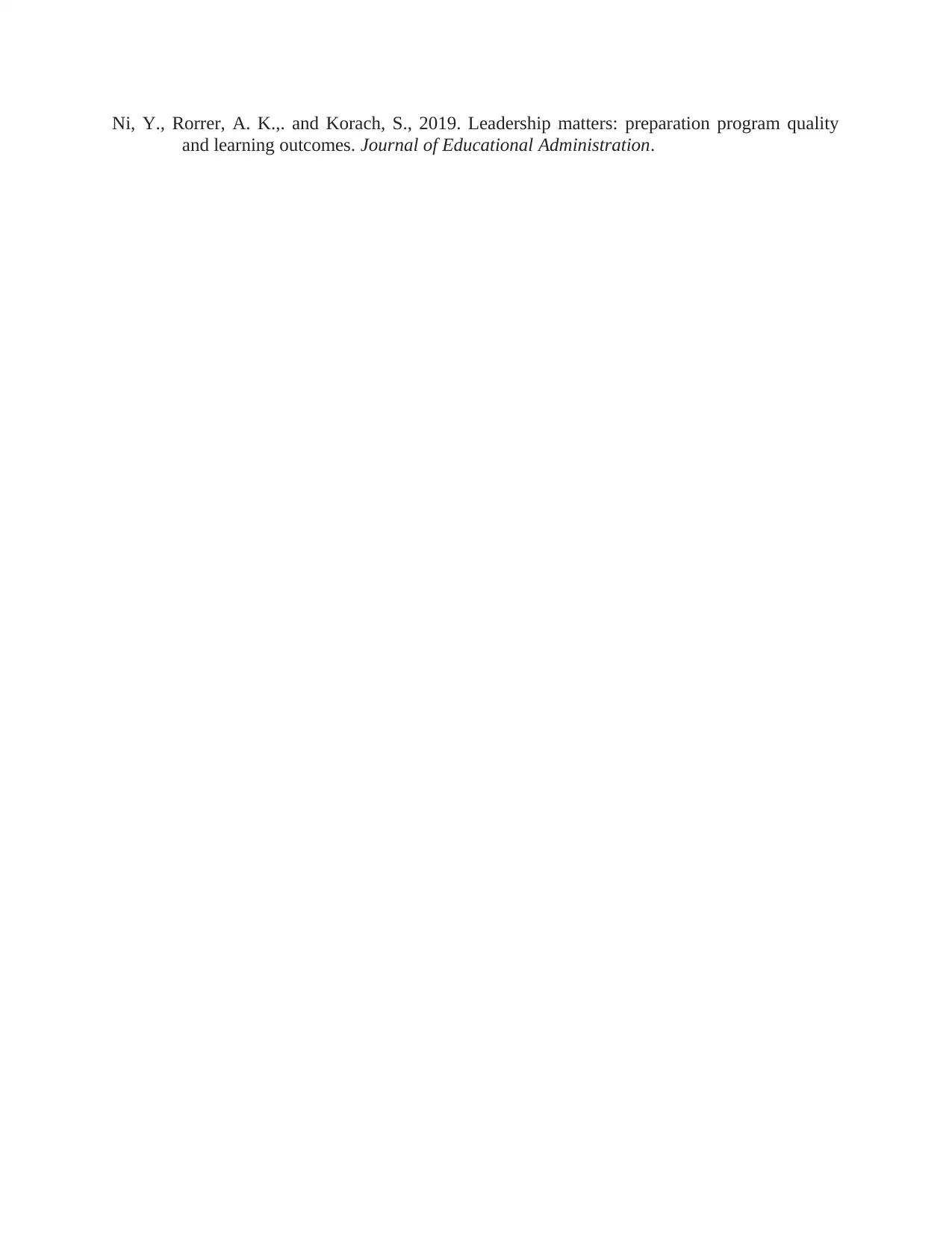
Ni, Y., Rorrer, A. K.,. and Korach, S., 2019. Leadership matters: preparation program quality
and learning outcomes. Journal of Educational Administration.
and learning outcomes. Journal of Educational Administration.
⊘ This is a preview!⊘
Do you want full access?
Subscribe today to unlock all pages.

Trusted by 1+ million students worldwide
1 out of 12
Related Documents
Your All-in-One AI-Powered Toolkit for Academic Success.
+13062052269
info@desklib.com
Available 24*7 on WhatsApp / Email
![[object Object]](/_next/static/media/star-bottom.7253800d.svg)
Unlock your academic potential
Copyright © 2020–2025 A2Z Services. All Rights Reserved. Developed and managed by ZUCOL.





